Egg Laying and Incubation - Up to 5 May
Straw started appearing in the box by the end of February and a bird was roosting in there. However, this has happened before so it was not until the end of March that the scale of activity really meant that nesting was a serious prospect.
The first two weeks of April saw frantic activity with feathers being added more and more, despite periods of prolonged wet weather. This has been the third wettest April on record in the UK.
I set up the camera links during this time and started recording the daytime activity, starting at 4am each day. The dawn chorus started just after 5am and before egg laying started the male could be heard calling from a nearby tree. On a number of ocassions, about 5.30-5.40am he would arrive at the box entrance and provide an early morning alarm call for the female inside.
I should point out that all times are British Summer Time (1 hour ahead of GMT).
This is a poor quality image of the moment when the first egg was laid at 6.25am on 13 April 2000. With a bit of imagination you can just see the egg below her right side.
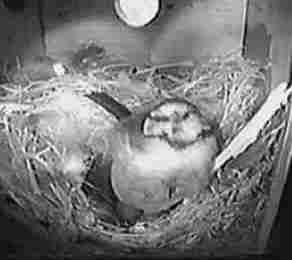 The
morning's activity actually started around 5.35am, when the male
arrived on the birch tree in front of the box and started calling
loudly. The female did not respond in any way to this. At 5.50
he arrived at the entrance and for the next five minutes called
from there while she remained fluffed up with her head under
her wing.
The
morning's activity actually started around 5.35am, when the male
arrived on the birch tree in front of the box and started calling
loudly. The female did not respond in any way to this. At 5.50
he arrived at the entrance and for the next five minutes called
from there while she remained fluffed up with her head under
her wing.
It was not until 6.10am that she started to move about. At just after 6.20, with the male now calling from the birch, she became very still. She was breathing at about 150 per minute and we could hear her making a series of quiet clicking sounds. As these continued she slowly raised her body up and moments later we saw the egg fall into the nest cup. After a short pause she then spent some time rolling the egg about as if she were drying. Then she sat on it, somewhat restlessly until she left the box at abot 6.35am.
Except for a couple of brief visits with feathers, which she leaves around the sides of the nest, she did not spend any time in the nest until she returned for the night at 6.50pm. The male continued to sing from a nearby tree for over an hour afterwards. I wonder where he spends the night?
Tuesday 18 April brought egg no.6, laid at 5.52am.
By now a pattern was emerging and the morning started with a wake up call from the male who arrived at the entrance at 5.35am and remained there, very noisy, for fifteen minutes. He even popped into the box very briefly. A few minutes before the egg was laid the female bcame still, and we heard the clicks before the egg was laid.
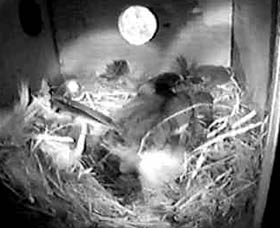
After about five minutes of housekeeping which included moving feathers to cover the eggs, she left the nest at 6.10am and, as usual, only make a couple of brief daytime visits before returning to roost at 7pm. It does mean that she spends about 11 hours sitting on the eggs in each 24 hour period so they do get some incubation time.
The video camera caught the moment of 'birth', although it was difficult to capture a still frame of it.
By Friday 21 April
we had seen 9 eggs laid, all early in the morning. However I
think that a tenth egg was laid in the evening of Good Friday,
the sound effects seemed to be right at least!
After that the female started to incubate the eggs, staying on
them longer each day.
On Monday 24 April (sunny afternoon, max17C) she was away from the nest nearly 7hrs. This included being away for 5hrs first thing in the morning (with only 5 brief visits to the box) and then making 15 more short excursions away throughout the rest of the day.
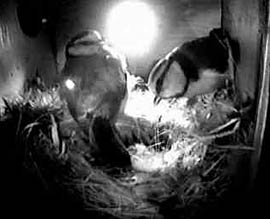
An image taken at 2.34pm Tuesday 25 April . The female blue tit, on the left, has just been fed with a mealworm by the male who is now inspecting the eggs as any expectant dad would! You can see that the male has a much bolder 'eye stripe' than the female.
This is the male at the mealworm feeding station next to my house. He will spend a short time pecking at the front end of the mealworm before he carries it back to the female.
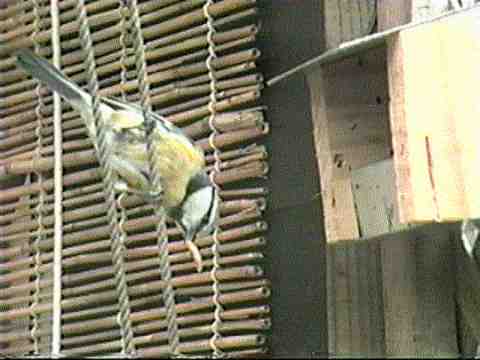
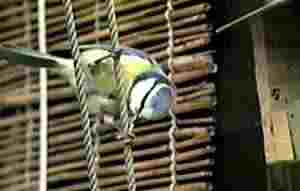
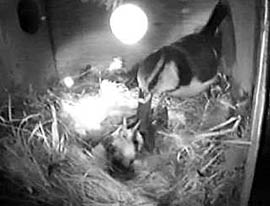
8.33am Wednesday 26
April -
Feeding time for the female.
After the Easter weekend the
incubation stage seems to be well established and the female
is spending increasing amounts of time on the eggs.
By Thursday 27 April
(some sunshine, max 18C) she left the nest for only 4hrs, made
up of 41 excursions, the longest being 35 minutes
Friday 28 April (cloudy, max 13C) saw her away from the nest for just over 3hrs, over a total of 33 trips, the longest being 12 minutes.
Each day the male makes more visits to the nest to feed her. On Thursday I recorded 14 visits, and Friday 21 visits. In addition, he also feeds her frequently when she is away from the nest. I have not yet managed to capture this on film.
On Sunday 30 April
(some sunshine, max 15C) the female was very active and the male
less involved. While he made just 13 visits to the box, between
5.35am and 7.15pm she made no less than 75 excursions from the
box. Despite that she was away from the nest just 3.5 hours.
With the exception of one 32 minute outing in the morning the
rest of the trips were very short. She appeared quite restless
and there were a few periods when she was in and out of the box
'like a yo-yo'. She also went to look out of the box quite frequently,
perhaps to check up on the human activity in the garden, or to
look out for the male as this happened in a couple of the long
intervals between his visits.
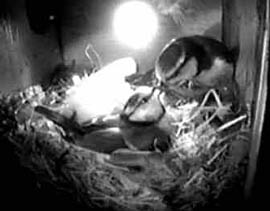
During one visit by the male the pair seemed to go though a ritual exchange of calls while the female held the food in her beak. She did not swallow it until after he had departed.. Moments later he returned and the following image from that sequence shows the female appearing to be pecking at the male's beak, causing him to regurgitate something.
Monday May 1 ( Bright with sunshine, max 16C)brought a quieter day on the home front. The female left the box for the first time at 5.34 and then made 59 trips out, totalling 3hr 20minutes before retiring early at 6.23pm. The longest trip lasted just 14 minutes. The male brought food to her in the box 15 times, 10 before 10.30am and the rest after 3pm.
On Tuesday May 2 (mainly cloudy, max 14C), in the eleven hours of activity between her first trip out at 5.37am and 'bedtime' at 6.39pm the female was only away from the box for 160 minutes, over 65 excursions. The longest trip was for 9 minutes. The male came to the box to feed her 18 times.
At one time in the day there was a definite lack of coordination between the pair. The male arrived with a mealworm only to find the box empty. He retired to the local birch tree to wait. When the female returned she first checked on her eggs and then appeared at the entrance and called. He quickly returned and handed over the food.
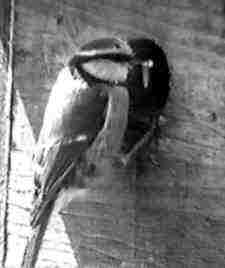
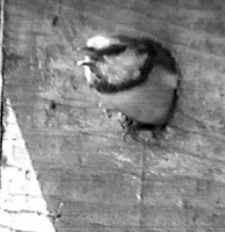
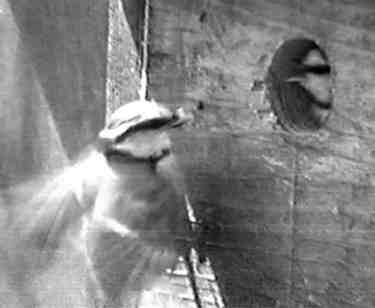
Wednesday 3 May was a dull, cloudy day (max 11C) with a damp northeasterly breeze. It saw the female greatly curtailing her outings. Between 5.47am and 7.08pm she made a total of only 36 trips, the longest being just 6 minutes, lasting a total of only 116 minutes. She spent a great deal of time with her feathers fluffed up and often tucked her head under her wing in her nighttime sleep position.
The male was much more involved on Wednesday with 39 visits to the box with food, mainly mealworms. In one half hour period she eat 7. Twice he arrived at an empty box. Interestingly, when he enters the box he always goes to the South side (in shadow) of the nest, whichever way the female may be facing.
When the female turns the eggs they rattle loud enough to be heard by anyone standing in the garden near the box.
As an aside to developments in the box, Wednesday saw the first flowers opening on the Hawthorn tree and our first sight this year of a pair of hedgehogs in their noisy courtship ritual. Also, there was a timely reminder of the perils that face the blue tits as they emerge into the world.
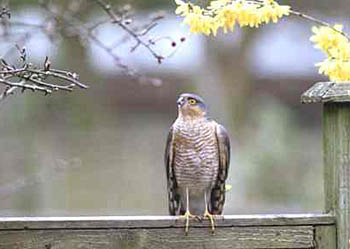
Our local sparrowhawk flew a lap around the Hawthorn to intimidate
the local house sparrows. It is a frequent visitor. However,
over a number of years I have only seen it catch one sparrow
and one starling, which it devoured on the ground right outside
our dining room window!
The picture shows a visit in April last year when it perched
on the fence to give the evil eye to the sparrows and a dunnock
trying to hide in the still leafless Hawthorn. It lost that game
of patience.
Thursday 4 May (mainly cloudy, sunshine pm, max 15C) saw the female make 39 trips out of the box between 5.43am and 6.49pm. The total time out was 190 minutes, with one trip lasting 59 minutes. The male fed her in the box 43 times during the day, mostly mealworms and there were two liquid(?) feeds.
Thursday evening has not yet brought the cracking of eggs, so the wait goes on. It is now 13 days since the last egg was laid so it must be getting close to the first hatching.
The day did bring an all too rare visit by a thrush, I think it was a mistle thrush, which spent a short time singing from the top of the trees at the bottom of the garden. Over the last few days there has been quite a bit of wren activity in and out of an ivy clump near the blue tits' box. The ivy has already been used successfully by blackbirds this spring. Last year blackbirds and dunnocks raised young in it.
Friday 5 May was to bring the breakthrough, so to speak, that everyone had been waiting for - the first egg to hatch.